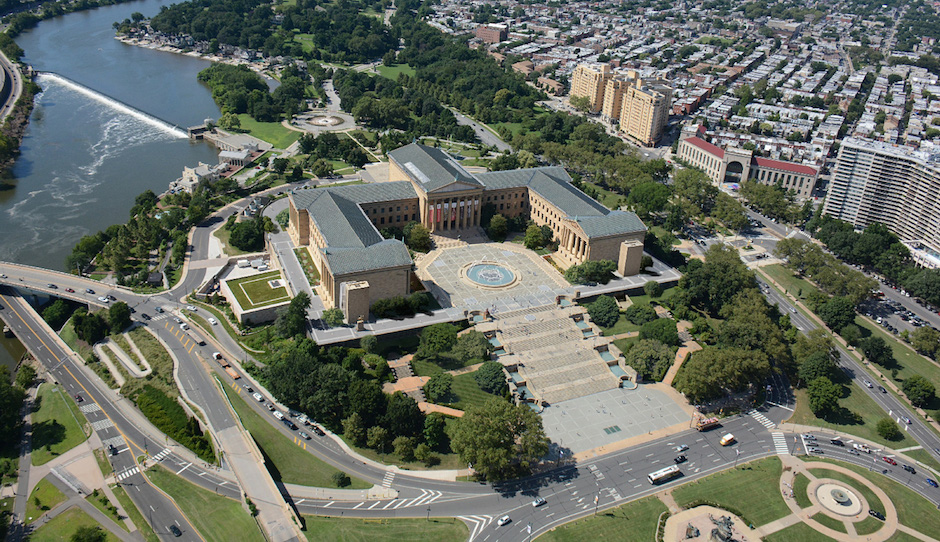Heller: “If You’re Going to Hire Gehry, Let’s Do Gehry”

East Terrace Aerial Mockup. Image via the Philadelphia Museum of Art.
Greg Heller, author of Ed Bacon: Planning, Politics and the Building of Modern Philadelphia, knows something about the planning and evolution of Philadelphia’s Parkway. Aside from Inga Saffron, there are few people I can think of more qualified to offer an opinion on Frank Gehry’s plans for the Philadelphia Museum of Art (PMA), now on view there in “Making a Classic Modern: Frank Gehry’s Master Plan for the Philadelphia Museum of Art.”
While other critics have basically said, “Thank god Gehry’s plans for the museum don’t seem very Gehry-ish” — in other words, he’s kept himself in check in our rather conservative, Quaker city — Heller finds himself disappointed by the absence of Gehry’s flamboyance:
The exhibit showcases the results of a design process that has been going on since 2006—seriously, that’s eight years of planning by one of the top architects of our time, famous for massive, ambitious, bizarrely shaped, twisted sculptures of metal that (like them or not) become a permanent and recognizable fixture in their cities’ urban landscapes. Even if I didn’t like the proposed renovation design, I figured at least it would be ambitious and interesting. It was neither.
Heller knew it wasn’t going to be Bilbao — after all, the design is primarily underground, as he notes — but he thought we might get something “iconic and visionary—perhaps our own version of I.M. Pei’s pyramid at the Louvre, but Gehryesque.” Instead, he says, Gehry has offered a pallid plan for an “amazingly boring” museum expansion.
[This plan] is essentially just a gallery expansion project, repurposing some parts of the museum that have been underutilized, creating additional gallery and educational space, opening up some skylights and windows. Really pretty dull stuff.
Heller was equally unimpressed by the exhibit itself, noting a not at all surprising thematic tendency:
It was also weirdly defensive in a Philadelphia-inferiority-complex type of way. Instead of talking about how amazing the renovation will be and how transformative it could be for the city, the exhibition seemed to immediately assume that the public would hate the design. It seemed like a major objective of the show was to defend some of the more controversial (but really, not that controversial) design aspects.
To be fair, the main design aspects the museum gets defensive about are changes to the museum steps, which have generated local and national articles focused either primarily or exclusively on Rocky angle. Nonetheless, defensiveness is the wrong tone for a museum exhibit; Philadelphia has always shot itself in the foot with tough-guy parochialism at the wrong times.
To quell any fears that Property readers might have: Gehry’s plan will not interrupt any triumphant runs up the steps, as it only carves out a space in the middle, so there are plenty of steps on either side. After a few months, people won’t even notice the changes.
And perhaps that’s the problem, Heller says:
…in terms of changing the museum’s perception in our city or creating any iconic architectural statement for the Parkway, it’s a big let down….
Look, I realize Gehry is not for everybody and there are a number of bold architects out there with distinctive styles. But if you’re going to hire Gehry, then c’mon let’s do Gehry. Let’s have big sinewy metal sculptural elements flying around the historic museum, creating a real past-meets-present statement that will change the face and image of our museum forever. Otherwise what’s the point?
There’s so much more in Heller’s piece, it’s tempting to simply keep going and talk about it all: a silly conversation he had with a curator, who said people think the museum is a bank (that would be the swankiest bank I’ve ever seen); the real reason people don’t go to the museum in large numbers; other Philly letdowns, like a downtown stadium; the terrible location of the museum; the Parkway being “pretty much a failure”; and what a city looks like where people really want to live. And Greg is such a nice guy (I know him personally), he feels guilty saying all of this, so there’s a mea culpa in there too.
For my part, I understand his wish for something bold and thrilling. But I’m more interested in his aside about the museum’s ticket price.
An aside of my own: A few years ago, I left journalism to work in social services at a program for low-income people with diagnoses of mental illness and/or mental retardation and sometimes both. Most of them lived in residences with people with similar diagnoses, and during the day, they would be transported to this day program where I worked, and they’d sit in classrooms and do pottery or storytelling or music or whatever. One day a colleague and I rented a van and went with a small group to the Art Museum. We knew we couldn’t go in because everyone was on disability/SSI, and funds were severely limited, even with a group discount. But being at the top of the steps and touching the columns of that enormous bank, er, museum, was pretty thrilling.
As it happened, they hadn’t planned to go in anyway because they didn’t think they were allowed. One woman said to me, “They let people like us go in?” That nearly broke my heart. I said, “They let anyone in because art is beautiful and everyone should be able to see it.” She said, “I always thought we weren’t allowed.”
And in a sense, they weren’t. They’d never be able to afford it, and limited transportation options and tight schedules at the residences made it impossible to take advantage of free hours.
Greg Heller writes, “As I left the exhibit today, the whole situation made me sad.” I know that feeling, even if it was for a different reason. And in a weird way, the pro-Rocky-steps people know that feeling too.
So many people in Philadelphia — pro-Gehry, anti-Gehry; pro-Rocky, anti-Rocky; frequent visitors, those who don’t go in — value this institution. So I’m happy that Heller, prompted by the PMA’s exhibit, is continuing the conversation about its future.
Gehry Disappointing [Urban Direction]


